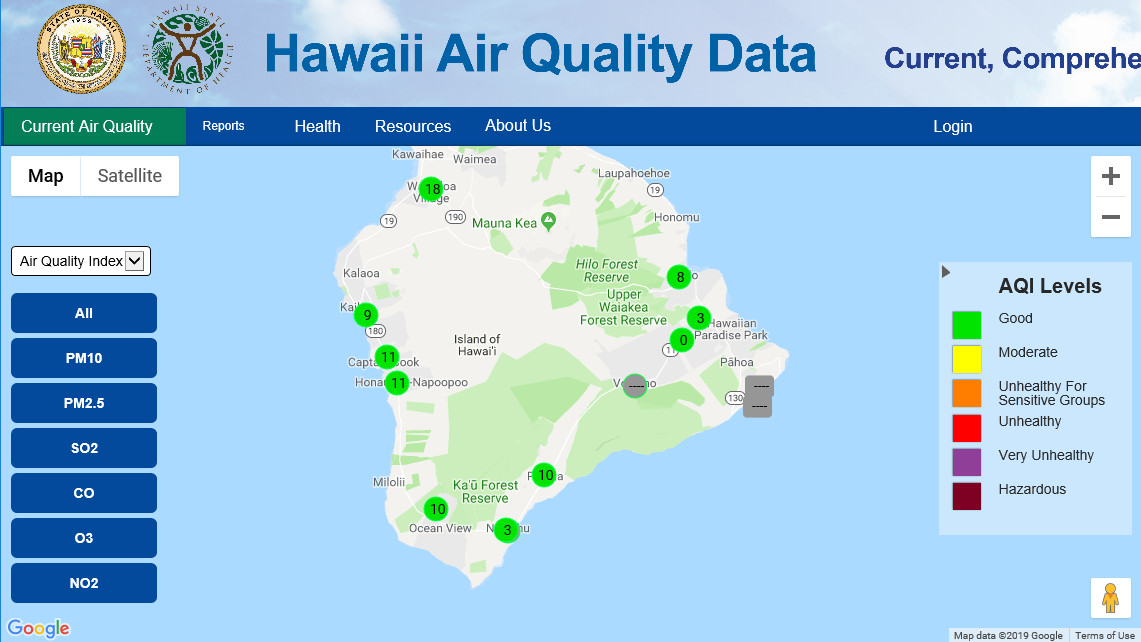(BIVN) – Skies over Hawaiʻi Island are crystal clear, now that the eruption of Kīaluea Volcano has ended; a stark contrast to conditions one year ago, when fissures tore open on the lower East Rift Zone, spewing gases that blanketed most of the Big Island in vog.
Now, one year after the lower East Rift Zone eruption began, the Hawaiʻi Department of Health has launched a new air quality advisory website, which officials say will enhance the state’s volcano-readiness.
This DOH media release was issued on Wednesday:
A new website that provides near real-time data on the air quality in Hawai‘i is now live to coincide with National Air Quality Awareness Week, which is recognized from April 29 – May 3. Residents and visitors to the islands now have a one-stop online resource for air quality information that is especially useful in the event of future volcanic eruptions.
Developed by the Hawai‘i Department of Health, data for the website is pulled from air quality monitoring stations at strategic locations throughout the state, the majority of which are on Hawai‘i Island. The public can access the data, which includes an interactive air quality map.
The unprecedented severity and duration of last summer’s Kīlauea eruption pointed to the need for useful, accessible and reliable data for residents affected by the resulting vog and other effects of the volcano. The Hawai‘i Department of Health was able to successfully secure more than $1.5 million in federal and state funds to expand and upgrade the state’s air quality monitoring system.
The funding enabled the state to invest in six new long-term stations, which have been located at Honaunau, Kailua-Kona, Kea‘au, Na‘alehu, Pahoa and Waikoloa. The total system now consists of 18 air quality monitoring stations statewide.
Implementation of the expanded air quality monitoring system was a collaborative, intradepartmental initiative between the health department’s Clean Air Branch and State Laboratories Division.
“Kīlauea provided valuable lessons for our state. Residents in communities on the Big Island were severely impacted by Kīlauea, especially those with respiratory conditions,” said Bruce Anderson, health director, who is a Hawai‘i Island resident himself. “There were numerous days during the eruption when the air quality was unhealthy and health effects were a concern. We listened to the concerns of residents, took action to improve our air quality monitoring system, and created a one-stop, user-friendly website. We’re much more volcano-ready than we have ever been.”
Marianne Rossio, manager of the Clean Air Branch, whose team oversaw the development of the website, said the online source combines ambient air quality concentrations and advises residents and visitors on potential health impacts using a six-tiered, color-coded system. This color-coded system, which is based on a national standard indicates whether the air quality is good, moderate, unhealthy for sensitive groups, unhealthy, very unhealthy, or hazardous and provides recommended actions for the public to protect their health in accordance with air quality conditions.
The Clean Air Branch in conjunction with the State Laboratories Division is responsible for the operation and maintenance of the statewide ambient air quality monitoring network. The Department of Health manages all of the state and local air monitoring stations (SLAMS), special purpose monitoring stations (SPMS), and the national core multi-pollutant monitoring station (NCore). Data collected from these sources is used to ensure compliance with National Ambient Air Quality Standards (NAAQS), for timely reporting of the U.S. Environmental Protection Agency’s (EPA) Air Quality Index (AQI), to track and characterize air quality trends, evaluate emission control strategies, and support health studies.
The EPA is commemorating Air Quality Awareness Week with the NOAA National Weather Service, the Centers for Disease Control and Prevention, the U.S. Forest Service, and the U.S. Department of State.
NOTE: Big Island Video News has reached out to the Department of Health for an explanation on what appears to be a lack of data being displayed in the Puna / Volcano regions of Hawaiʻi Island. We will share their response when it is provided.


by Big Island Video News4:13 pm
on at
STORY SUMMARY
HAWAIʻI ISLAND - The Hawai‘i Department of Health launched a new air quality advisory website to enhance the state’s volcano-readiness, officials announced on Wednesday.